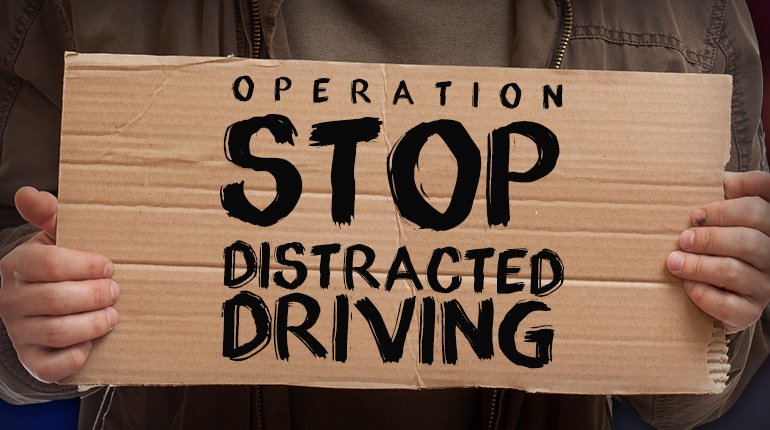April is Distracted Driving Awareness Month and is the perfect time for motor carriers to remind their drivers of the dangers of distracted driving and the rules and regulations enforced by the FMCSA. Did you know your brain can miss seeing up to 50% of your driving environment when you talk on a cell phone? Research shows drivers talking on cell phones had slower reaction times than drivers with a .08 blood alcohol content.
According to these regulations, Commercial Motor Vehicle (CMV) drivers are prohibited from texting or using hand-held mobile phones while operating their vehicles. Violations can result in fines and disqualifications and impact a motor carrier’s and driver’s Safety Management System (SMS) results. The rules also restrict a CMV driver from reaching for or holding a mobile phone to conduct voice communication and dialing by pressing more than a single button. CMV drivers who use a mobile phone while driving can only operate a hands-free phone located in proximity. In short, the rule prohibits unsafely reaching for a device, holding a mobile phone, or pressing multiple buttons.
The rules impose sanctions for driver offenses, including civil penalties of up to $2,750 and disqualification for multiple offenses. Motor carriers are also prohibited from requiring or allowing their drivers to text or use a hand-held mobile phone while driving and may be subject to civil penalties of up to $11,000. Violations will impact SMS results.
This month reinforce to your drivers the dangers of distracted driving. It’s effortless to comply with the rules:
No REACHING, HOLDING, DIALING, TEXTING, or READING.
Banning Distracted Driving: An Employer's Guide to Protect Employees and Liability
- Implement a clear policy indicating that the employer does not require employees to answer calls on the road. This policy includes the employer placing calls to employees while they are driving.
- Encourage your employees to plan their trips to include stops so they can safely return calls and emails.
- Establish a company policy that makes it unnecessary for employees to text while driving to fulfill their duties.
- Eliminate incentives that may encourage employees to text/talk while operating a vehicle.
- Communicate your state's regulations and associated fines to employees.
- Encourage employees to sign an anti-distracted driving pledge.
- Designate company vehicles as "distraction-free zones."
For additional information on distracted driving, visit the following websites:
https://www.fmcsa.dot.gov/ourroads/distracted-driving-shareable-materials
The FMCSA Drug and Alcohol Clearing House Frequently Asked Questions:
- What is the Drug and Alcohol Clearinghouse (Clearinghouse), and what information does it contain?
The Clearinghouse is a secure online database that gives employers, the Federal Motor Carrier Safety Administration (FMCSA), State Driver Licensing Agencies (SDLAs), and State law enforcement personnel real-time information about commercial driver’s license (CDL) and commercial learner’s permit (CLP) holders’ drug and alcohol program violations.
The Clearinghouse contains records of violations of drug and alcohol prohibitions in 49 CFR Part 382, Subpart B, including positive drug or alcohol test results and test refusals. When a driver completes the return-to-duty (RTD) process and follow-up testing plan, this information is also recorded in the Clearinghouse.
- How does the Clearinghouse impact employers of commercial driver’s license (CDL) and commercial learner’s permit (CLP) holders?
The Clearinghouse offers employers a centralized location to query driver information and report drug and alcohol program violations incurred by current and prospective employees holding CDLs and CLPs. The employer must use the Clearinghouse to:
- Conduct a full query of the Clearinghouse as part of each pre-employment driver investigation process.
- Conduct limited queries at least annually for every driver they employ.
- Request electronic consent from the driver for a full query, including pre-employment queries.
- Report drug and alcohol program violations.
- Record the negative return-to-duty (RTD) test results and the date of successful completion of a follow-up testing plan for any driver they employ with unresolved drug and alcohol program violations.
- Are employers required to query the Clearinghouse or report drug and alcohol program violations for drivers who do not hold a commercial driver’s license (CDL) or commercial learner’s permit (CLP)?
No. Only employers who employ drivers subject to the licensing requirements in 49 CFR Part 383 and the drug and alcohol testing requirements in 49 CFR Part 382 must query or report information in the Clearinghouse. However, employers of drivers not holding a CDL or CLP must still comply with the driver investigation requirements of § 391.23(e), which includes drug and alcohol violation history.
- Can an employer or medical review officer (MRO) enter a drug and alcohol program violation in a CDL driver’s Clearinghouse record if the driver is not registered for the Clearinghouse?
Yes. When a violation is entered, the Clearinghouse associates it with a driver’s commercial driver’s license (CDL) information. This will be recorded even if the driver has not registered for the Clearinghouse. When an employer queries a driver’s information in the Clearinghouse (with the appropriate consent), they will enter the driver’s CDL information to verify any violations associated with that driver’s CDL.
A driver is required to enter their CDL information during their Clearinghouse registration. This allows them to view any violation or return-to-duty (RTD) information associated with their CDL.
- What is considered actual knowledge of a violation?
Yes. When a violation is entered, the Clearinghouse associates it with a driver’s commercial driver’s license (CDL) information. This will be recorded even if the driver has not registered for the Clearinghouse. When an employer queries a driver’s information in the Clearinghouse (with the appropriate consent), they will enter the driver’s CDL information to verify any violations associated with that driver’s CDL.
A driver is required to enter their CDL information during their Clearinghouse registration. This allows them to view any violation or return-to-duty (RTD) information associated with their CDL.
- How will CDL drivers be notified when information about them is added to the Clearinghouse?
The Clearinghouse will notify the driver using the method indicated during the driver’s Clearinghouse registration—either by mail or email—any time information about the driver is added, revised, or removed. If the driver has not yet registered for the Clearinghouse, these notifications will be sent by mail using the address associated with the driver’s commercial driver’s license (CDL).
- How long will CDL driver violation records be available for release to employers from the Clearinghouse?
Driver violation records will be available in the Clearinghouse for five years from the determination date or until the violation is resolved through the successful completion of the return-to-duty (RTD) process and follow-up testing plan, whichever is later.
- What is the timeframe in which an employer must submit a report of an employee’s drug and alcohol program violation to the Clearinghouse?
Employers must report a drug and alcohol program violation by the close of the third business day following the date the employer obtained the information.
- What actions should an employer take if notified of a change to a driver’s Clearinghouse record?
When an employer receives a notification that there is a change to the information in a driver’s Clearinghouse record, the employer should complete a full follow-on query within 24 hours to determine if the new information prohibits the driver from performing safety-sensitive functions, such as operating a commercial motor vehicle (CMV).
For the employer to conduct the follow-on query, the driver must provide specific consent electronically in the Clearinghouse. Following 49 CFR 382.703(c), if the driver refuses to grant specific consent, the employer must remove the driver from safety-sensitive functions until a full query is conducted and the results obtained. Once the full query is conducted, the driver may resume safety-sensitive functions only if the query returns a “Not Prohibited” status.
- Are Canadian and Mexican CDL drivers conducting operations in the United States subject to the Clearinghouse requirements?
Yes - all Mexican or Canadian employers, employees, or service agents operating in the United States subject to the Federal Motor Carrier Safety Administration (FMCSA) drug and alcohol testing requirements must comply with the Clearinghouse final rule.









